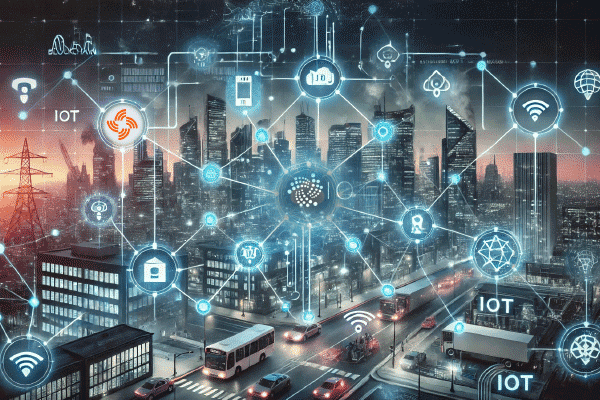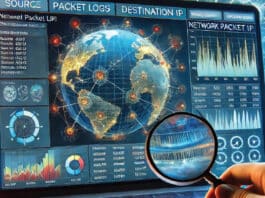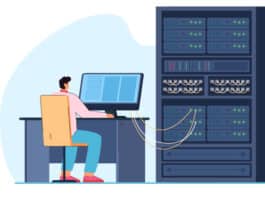Explore how blockchain is being integrated with IoT to create decentralised networks. Find out how leading open source projects like IOTA and Streamr use blockchain to ensure data integrity, security, and privacy in IoT ecosystems.
The Internet of Things (IoT) has revolutionised how devices interact, communicate, and collect data, powering everything from smart homes and healthcare devices to autonomous vehicles and industrial automation systems. By 2030, over 50 billion devices are expected to be connected to the internet, producing an unprecedented volume of data. However, as the number of connected devices grows, the challenges associated with centralised IoT systems have become more apparent: security vulnerabilities, lack of privacy, data manipulation risks, and scalability issues.
To address these challenges, blockchain technology, coupled with decentralisation, has emerged as a promising solution. Decentralised IoT, powered by blockchain, offers several advantages, including improved data security, privacy, and transparency, all without relying on central servers or intermediaries. Open source technologies play a crucial role in accelerating the adoption of decentralised IoT by offering flexible, transparent, and collaborative development platforms.
The basics: What is decentralised IoT?
To fully understand decentralised IoT, it’s important to first break down the core concepts: IoT (Internet of Things), blockchain, and decentralisation. These are the building blocks that enable the next generation of IoT systems that are more secure, scalable, and transparent than traditional, centralised networks.
IoT (Internet of Things): IoT refers to a network of physical devices, vehicles, appliances, sensors, and other objects embedded with software, sensors, and network connectivity that allow them to collect and exchange data. IoT systems are designed to enable automation and intelligent decision-making by connecting devices to the internet, thereby creating a smart ecosystem. The key characteristics of IoT are:
- Interconnectivity: IoT devices are interconnected, enabling them to exchange data with one another. This could be as simple as a smart thermostat communicating with a home’s heating and cooling system, or as complex as industrial machines sharing data with cloud-based analytics platforms.
- Automation: IoT allows for real-time decision-making and automation. For example, IoT-enabled smart homes can adjust lighting and heating based on user preferences or environmental factors.
- Data generation: IoT devices generate vast amounts of data, which can be used to optimise processes, improve efficiency, and enhance user experiences. In industries like healthcare or agriculture, IoT devices can track vital signs, soil moisture levels, or crop health, allowing for real-time monitoring and intervention.
However, as IoT networks grow, they face several challenges, including security vulnerabilities, lack of control over data, and dependency on centralised cloud platforms. This is where decentralisation and blockchain technology can come into play to solve these problems.
Blockchain: Blockchain is a distributed ledger technology (DLT) that records transactions in a secure, transparent, and immutable manner. Each block in a blockchain contains a set of transactions, and these blocks are linked together in a chronological order to form a chain. Blockchain’s key feature is its decentralisation — there’s no central authority controlling the data, and every participant (node) in the network has access to the same information. Here are the key characteristics of blockchain.
- Immutability: Once a transaction is recorded in a blockchain, it cannot be altered or deleted. This ensures data integrity, making it tamper-resistant.
- Transparency: Blockchain is public and transparent, allowing anyone to view the transactions recorded on the ledger, which is vital for trust and accountability in decentralised networks.
- Security: Blockchain uses cryptography to ensure that data transactions are secure and only authorised participants can add new transactions to the ledger. This makes blockchain an ideal solution for securing IoT networks, where data privacy and authenticity are critical.
- Decentralisation: Rather than relying on a central server, blockchain is maintained by a distributed network of nodes. Each node validates transactions, ensuring that the system is decentralised and fault-tolerant.
When applied to IoT, blockchain ensures that data from devices is securely recorded and can be verified without relying on a central authority, which enhances security and trust among devices in the network.
Decentralisation: Decentralisation refers to distributing control across a network, removing the need for a central governing entity or authority. In traditional IoT systems, devices and data are typically managed through centralised cloud platforms or servers, creating potential single points of failure, bottlenecks, and security risks.
In a decentralised IoT network, no central server or entity controls the data flow or manages the devices. Instead, devices communicate directly with each other using decentralised protocols, and transactions or data exchanges are verified and recorded using blockchain technology. The key characteristics of decentralisation are:
- Peer-to-peer communication: In decentralised IoT, devices can communicate with each other directly without the need for an intermediary. This reduces latency, speeds up decision-making, and lowers the dependency on central servers.
- Distributed control: Instead of a single centralised authority managing devices and data, control is distributed among network participants. Each device can act as both a producer and consumer of data, ensuring that decisions are made locally, improving speed and responsiveness.
- Resilience and redundancy: By distributing data and control across multiple devices or nodes, decentralised IoT systems are more resilient to failures. Even if one node or device goes offline, the network can continue to function without significant disruption.
- Privacy and security: Decentralisation enhances privacy by allowing IoT devices to exchange data without relying on a third-party cloud service. Blockchain further strengthens privacy by encrypting and anonymising data exchanges.
Decentralised IoT versus centralised IoT
In centralised IoT systems, data is routed through a central cloud platform or server, where it is processed, stored, and analysed. While this centralised approach allows for easier management and control, it introduces several vulnerabilities.
Single points of failure: A centralised IoT system depends on a single server or cloud infrastructure, making it a target for cyberattacks. If the central server goes down or is compromised, the entire system can fail.
Data privacy concerns: In centraliaed systems, all data is stored in one place, raising concerns about how that data is used, shared, and protected.
Scalability issues: Centralised platforms can become overwhelmed as the number of connected devices increases, leading to latency and performance issues.
In contrast, decentralised IoT systems eliminate the need for centralised control, using blockchain and peer-to-peer communication to securely and efficiently exchange data across devices without intermediaries. This offers several benefits.
Improved security: By distributing control across the network, there is no single target for attacks. Additionally, the use of blockchain ensures that data is tamper-proof and verifiable.
Enhanced privacy: Devices can exchange data directly without needing to rely on a third-party cloud platform, reducing the risk of data breaches or unauthorised access.
Scalability: Decentralised networks can scale more efficiently since they don’t rely on centralised infrastructure. The addition of more devices simply adds more nodes to the network, rather than overloading a central server.
Why blockchain for IoT?
Blockchain technology offers numerous advantages that directly address the challenges faced by centralised IoT networks.
Data integrity and privacy: IoT devices generate vast amounts of sensitive data, from health information to environmental sensors. Blockchain ensures that this data is immutable and secure by creating a tamper-proof record of all transactions. Every data exchange between IoT devices is verified, reducing the risk of data manipulation and ensuring privacy.
Security: Centralised IoT systems are often vulnerable to cyberattacks. Hackers targeting the central server can gain access to the entire network. Blockchain-based decentralised systems, on the other hand, eliminate this risk by distributing control across all network participants. Each device in the network validates transactions, ensuring the system’s resilience against attacks.
Trust and transparency: Blockchain eliminates the need for a trusted third party by allowing devices to communicate and share data securely in a trustless environment. Transactions are recorded on a public ledger that is accessible to all participants, ensuring complete transparency and enabling participants to verify data integrity without relying on any central authority.
Decentralised control: In a decentralised IoT system, devices communicate directly with each other, without the need for a centralised server to manage communication. This peer-to-peer architecture reduces latency and improves real-time decision-making, which is essential in many IoT applications, such as autonomous vehicles or smart grids.
IOTA: Enabling scalable and secure IoT networks
IOTA is one of the most prominent projects in the decentralised IoT space. Unlike traditional blockchain platforms, IOTA uses a unique structure called the Tangle, a directed acyclic graph (DAG). This architecture enables IOTA to scale efficiently and avoid some of the common limitations of blockchain, such as high transaction fees and low throughput. The key features of IOTA are:
Scalability: The Tangle architecture allows for fee-less transactions and high scalability, making it ideal for IoT applications where devices communicate frequently and exchange small amounts of data.
Secure data exchange: IOTA ensures secure communication between devices by storing data on the Tangle, making it tamper-proof and verifiable.
Microtransactions: It enables secure and efficient microtransactions, which are vital for IoT ecosystems where devices often exchange small amounts of data or value.
Zero fees: IOTA eliminates transaction fees, a critical feature for IoT networks that need to handle frequent, small data exchanges.
Here are a few use cases of IOTA.
Smart cities: IOTA’s fee-less transactions and scalability make it a great fit for smart city applications, such as smart parking, environmental monitoring, and energy management.
Supply chain management: Its ability to track goods across the supply chain and securely share data in real time makes it ideal for logistics and inventory management.
Autonomous vehicles: IOTA’s scalable and secure network enables autonomous vehicles to communicate with each other and exchange data, improving traffic management and safety.
Streamr: Real-time data stream processing for IoT
Streamr is a decentralised data platform that focuses on real-time data streams, enabling IoT devices to share and process data in real time. By leveraging blockchain, Streamr ensures the data is authentic, and that its ownership and privacy are maintained throughout its exchange. Its key features are:
Real-time data processing: Streamr allows IoT devices to transmit data in real time, reducing latency and enabling faster decision-making.
Decentralised data marketplace: Its platform includes a decentralised marketplace where users can buy and sell data streams. This opens up new opportunities for monetising IoT data while ensuring data privacy.
Blockchain integration: Streamr integrates blockchain technology to ensure transparency and authenticity in the data exchange process. All transactions are recorded on the blockchain, ensuring data integrity.
Privacy: It allows IoT data to be shared anonymously, protecting user privacy while facilitating valuable data exchange.
This decentralised data platform has quite a few use cases.
Smart cities: In a smart city setup, Streamr can help with real-time data sharing between infrastructure, devices, and city administrators to improve traffic management and urban planning.
Industrial IoT: Streamr’s real-time data processing is particularly useful in industrial IoT environments, where sensors and machinery need to be monitored for predictive maintenance and optimisation.
Financial services: Its decentralised marketplace for data can enable financial institutions to access real-time data streams for market analysis, predictive models, and decision-making.
The role of open source in decentralised IoT
Open source projects like IOTA and Streamr play a critical role in accelerating the adoption of decentralised IoT. Open source code allows anyone to inspect, audit, and contribute to the development of IoT networks, ensuring transparency and trust.
Transparency: Open source projects provide full visibility into the code, allowing users to verify the system’s integrity and security.
Collaboration: Open source platforms encourage collaboration between developers, businesses, and researchers, accelerating innovation in the decentralised IoT space.
Innovation: Open source IoT projects foster innovation by allowing anyone to build on existing code, experiment with new ideas, and create new applications that leverage decentralised IoT networks.
By enabling greater collaboration and transparency, open source projects are crucial to building the decentralised IoT networks of the future.
As IoT continues to expand, the integration of blockchain and open source platforms will be key to unlocking the full potential of connected devices, enabling a future where data flows freely, securely, and transparently across the world’s networks.




